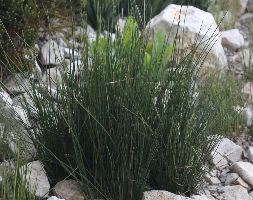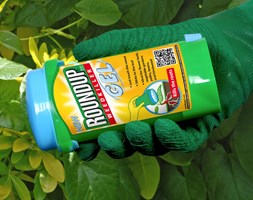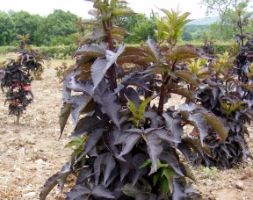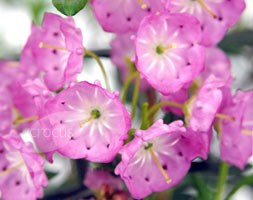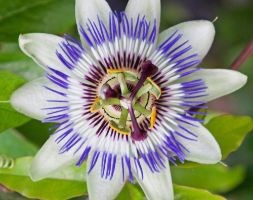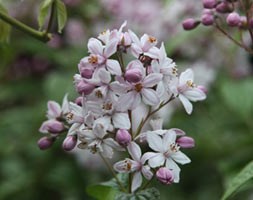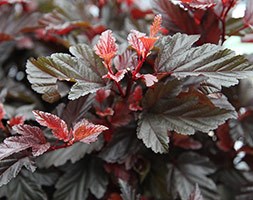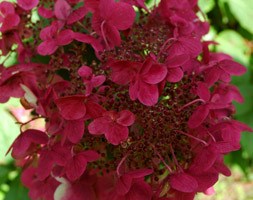Price reductions at Crocus
by Sarah - December 9th, 2015.Filed under: Crocus, Price Reductions.
Crocus has cut the price of these items
Juncus effusus (soft rush) was £9.99 now £4.99
Position: full sun or partial shade Depth of water: 0-8cm (0-3in) Rate of growth: average Flowering period: June to August Flower colour: insignificant brown flowers Hardiness: fully hardy Commonly found on damp moors and grassland, this perennial makes a fine addition to the margins of a pond. The upright stems are dark green and in summer are accompanied by tight clusters of small brown flowers. Wonderful for adding vertical interest beside water, it will also grow in pots and containers provided there is reliable moisture. Garden care: From mid-spring to early summer lift and divide congested colonies.
Gillenia trifoliata (bowmans root) was £7.99 now £6.99
Position: partial shade Soil: fertile, well-drained soil, neutral to slightly acidic soil Rate of growth: average Flowering period: June Hardiness: fully hardy A charming perennial that bears masses of delicate, star-shaped white flowers in midsummer. In autumn, the pretty, three-leafed foliage turns fiery red and the winter seedheads are a bonus too. Lovely towards the front of a shady, woodlan d border, where the flowers can be appreciated. Garden care: Divide congested plants in spring or autumn. Protect young shoots from slug attack.
Roundup weedkiller gel was £8.99 now £7.99
This is a unique weeding tool which is ideal for treating weeds in difficult areas. Simply apply the gel to the weed and the gel will kill the weed right to the roots so they do not come back. This product is perfect for difficult areas such as beds, borders and vegetable patches as this is not applied to the roots but the weed itself. To make sure the weedkiller reaches the roots quickly, Roundup gel should be used when the weed is growing and has a large enough leaf area. To tackle perennial weeds, apply your Roundup gel before they flower, otherwise seeds may disperse and result in more weeds. Contains glyphosate As for children and pets, keep them out of the area while you are using roundup gel and then once the area is dry you can let them re-enter.
Sambucus nigra f. porphyrophylla Black Tower = ‘Eiffel 1’ (PBR) (black tower elder) was £14.99 now £9.99
Position: full sun or partial shade Soil: moderately fertile, humus-rich, moist, well-drained soil Rate of Growth: average Flowering period: June fruits are attractive to birds Hardiness: fully hardy This tall and slender deciduous shrub is primarily grown for its foliage, which emerges green in spring, but (if exposed to lots of sun) will soon turn a deep burgundy colour. In early summer, the stems are crowned with big, flattened sprays of lightly perfumed, small pink flowers. It makes a dramatic stand-alone statement, and is useful for adding contrast and interest to the shrub border. Garden care: To achieve the best foliage effect cut back to ground level each year in early spring and apply a generous 5-7cm mulch of well-rotted garden compost or manure around the base of the plant.
Kalmia polifolia (Eastern bog laurel) was £12.99 now £9.99
Position: partial shade Soil: reliably moist, humus-rich, acid soil (or ericaceous compost for container-grown specimens) Rate of growth: average Flowering period: April to May Hardiness: fully hardy Clusters of saucer-shaped pink flowers appear in mid- to late-spring on this low-growing evergreen shrub. Suitable for a woodland garden setting or shrub border, it will tolerate full sun provided there is a reliable source of moisture. Garden care Best in partial shade, it requires moist, humus-rich acid soil and an annual spring mulch of well-rotted leaf mould or composted pine needles. Remove the faded blooms regularly to prolong flowering. Requires minimal pruning – cut back specimens that have outgrown their allotted space gradually over two or three years in spring. Apply a generous mulch of well-rotted leaf mould or composted pine needles around the base of the plant each spring.
Passiflora caerulea (blue passion flower) was £12.99 now £9.99
Position: full sun or partial shade Soil: moderately fertile, moist, well-drained soil Rate of growth: fast-growing Flowering period: July to September Hardiness: frost hardy (will need winter protection in cold areas) A really exotic-looking plant, with large white flowers and central filaments of purple, blue and white from July to September, followed by egg-shaped, orange-yellow fruit. The leaves are pretty, too; deeply lobed, dark green and glossy. This blue passion flower is a vigorous, trouble-free climber that thrives in hot summers and will quickly cover a sunny wall or fence. Ideal for a tropical planting scheme, it grows best at the base of a sheltered wall in full sun, although it will tolerate some shade. The fruit are edible when full ripe, but not very tasty! Passion flowers are believed to represent the suffering of Christ on the cross and the mysteries of the Passion. The 17th century monastic scholar, Jacomo Bosio, describes ‘the column rising in the centre of the flower surrounded by the thorn of crowns (and) the three nails at the top of the column. In between, near the base of the column is a yellow colour about the size of a reale, in which there are five spots or stains (stamens) of the hue of blood evidently setting forth five wounds received by our Lord on the cross.’ Garden care: Choose three to five of the strongest shoots, tying them in to horizontal wires. Once the plant is established, cut back the flowered shoots immediately after flowering to within two or three buds of the permanent framework of the plant. In spring remove dead, misplaced or overcrowded stems.
Deutzia x hybrida Mont Rose (deutzia) was £12.99 now £9.99
Position: full sun or partial shade Soil: any fertile, well-drained neutral to alkaline soil Rate of growth: fast growing Flowering period: June to July Flower colour: rose pink Hardiness: fully hardy Dense clusters of star shaped, rose pink flowers and slender, dark green leaves. This elegant, summer flowering shrub is an excellent specimen plant for smaller gardens. Although best in full sun it tolerates light shade and alkaline soil. Garden care: To encourage a bushy habit tip-prune young plants, either by pinching off the tips of soft shoots or by reducing long leading or lateral shoots by a third. Immediately after flowering, cut back the stems that have flowered to one or two healthy buds.
Physocarpus opulifolius Little Angel = ‘Hoogi016’ (PBR) (ninebark) was £11.99 now £9.99
Position: full sun or partial shade Soil: preferably acid, fertile, moist but well-drained soil Rate of growth: average Flowering period: June Hardiness: fully hardy This ninebark has only just been introduced, but already it is winning awards. It has a well-branching structure that means there is lots of lush foliage, which is bright orange-red when it first appears, but will mature to a darker shade of burgundy-red. This colouring is very useful for adding depth of colour and contrast to the mixed or shrub border, and in early summer, the clusters of white flowers (and subsequent fruit) offer even more interest. A compact plant, it will also look great in a pot on the patio. Garden care: Prune old stems back to the base after flowering. After pruning apply a generous 5-7cm (2-3in) mulch of well- rotted garden compost around the base of the plant.
Hydrangea paniculata ‘Wim’s Red’ (PBR) (hydrangea) was £14.99 now £11.99
Position: full sun or partial shade Soil: moist, well-drained, moderately fertile, humus-rich soil Rate of growth: fast-growing Flowering period: July – October Other features: the flower-heads make excellent dried flower arrangements Hardiness: fully hardy A new form with strong stems that carry 30cm-long honey-scented flower clusters, which turn from white to pink, then intensify in colour as they mature to a rich wine red. Its long flowering period and chameleon-like tendencies make it a great investment for the shrub border. Garden care:To enhance flowering prune hard in early spring, cutting back the previous season’s shoots to within a few buds of the permanent, woody framework of the plant.







